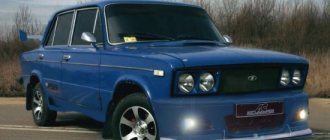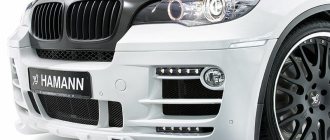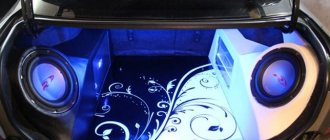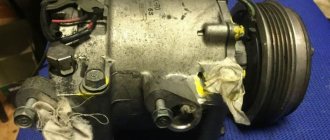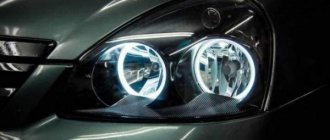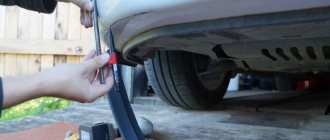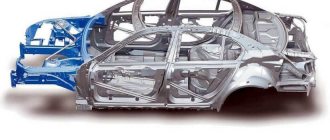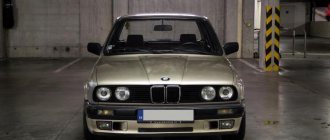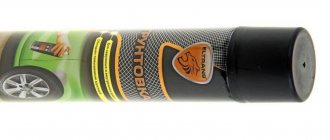Body types [edit | edit code]
Closed [edit | edit code]
- Sedan
: the most common body type, can be two- or four-door, in rare exceptions it can have five doors (including the trunk). A distinctive feature is the presence of two rows of full-size (that is, suitable for quite comfortable accommodation of adults) seats and the absence of a door in the rear wall. Representative - VAZ-2101, Toyota Camry.
- Including the two-door sedan
, or
(outdated) Tudor
: it differs from the coupe in having full two rows of seats and a normal (like a four-door sedan) base. The representative is the two-door Zaporozhets.
- Station wagon
: usually a two-volume, five-or less often three-door cargo-passenger body based on a sedan with a door in the rear, a rear overhang like a sedan or longer. Representatives - VAZ-2102, VAZ-2104, GAZ-22, GAZ-24-02, Moskvich-423, Moskvich-426, Moskvich-427, VAZ-2111, VAZ-1117, VAZ-2171, Lada Largus. - Hatchback
: usually a two-volume cargo-passenger body, with three or five doors, is related to a station wagon, but has a shorter rear overhang and, accordingly, less load capacity. Representatives - VAZ-2109, Moskvich-2141. - Coupe
: two-door three-volume body, with one row of seats, or with a rear seat of limited capacity (for children, or for short, uncomfortable accommodation of adult passengers); often with a pronounced sporty look, but there are also luxury (executive) coupes that provide maximum comfort to the driver and front seat passenger. Representative - Cadillac Eldorado. Often the commercial name “coupe” is used for cars with other bodies that have two side doors, for example, three-door hatchbacks. - Limousine
: a closed body of a luxury car based on a sedan with an extended wheelbase and a partition behind the front seat. It should be distinguished from a simple long-wheelbase sedan without a partition. - Minibus
: the name speaks for itself. - Minivan
: usually single-volume or double-volume with a half-hood layout, body, an intermediate option between a station wagon and a minibus. Sometimes in domestic literature it is called UPV (high-capacity station wagon). May have sliding doors for the second row of seats. Can be equipped with a third row of seats. Representatives: Dodge Grand Caravan, Honda Odyssey, Toyota Sienna. - Hardtop
: not a separate type, but rather a design option for a sedan, coupe, station wagon and other bodies; Hardtops typically lack a B-pillar and glass frames for better appearance, visibility, and ventilation, which greatly reduces the rigidity of the hardtop body and has been the reason for its rarity since the 1980s. The most common were hardtop modifications of sedans (both two- and four-door) and coupes. - Town car
: a passenger car with a high roof. Typically this type of body is used in taxis. Representative - MetroCab. - Combi
: in German-speaking countries, this is the name given to any body with a door in the rear wall, including station wagon, hatchback and liftback; In the USSR, “Kombi” was the name given to the IZH-2125 car, which was very close in type to a liftback. - Liftback
: a hatchback with a long rear overhang, like a sedan; can have two volumes and a sloping roof, like most hatchbacks, or three volumes (Slavuta, Škoda Octavia). - Fastback
: refers to various types of car bodies that have a special sloping roof shape, smoothly, without a step, turning into the trunk lid. - Convertible
: an open car body, two or four doors, usually with a soft or hard folding roof, having roll-up side windows; in the folded position, the roof is placed in the trunk or in the space between the trunk and passengers; Convertibles with a hard folding roof are often called coupe cabriolets (English coupé cabriolet, American English coupé convertible). Usually the names of such cars have the prefix “CC”, for example, Peugeot 206 CC. - Roadster
: two-seater body style with folding soft top (example: MINI John Cooper Works Roadster) - Phaeton
: four-door car body with a soft folding roof for five to six seats without side windows; nowadays this is sometimes called the four-door convertible of the highest class, like the ceremonial ZIL convertibles. - Landau
: a car whose roof over the passengers is soft folding (Representative - 1929 Chevrolet International Series AC Imperial Landaulet) or hard removable. - Brogam
: a type of passenger car body that has a removable or foldable roof section over the front row of seats. This body type is also known as “coupe de ville”. - Targa
: a type of automobile body of a passenger car, a type of sports 2-seater roadster with a rigidly mounted windshield, a roll bar behind the seats, a removable roof and a rear window (not always). Representative, first and one of the few - Porsche 911 Targa. - Spider
: open two-door car body. Unlike the roadster, the upper edge of the windshield is located significantly below the driver's (more precisely, pilot's) eyes or is absent altogether. - Shooting brake
: The history of the term shooting brake dates back to the 19th century, when this was the name for vehicles used to transport a group of hunters, their equipment and game. The word brake in this case means “cart” - that’s what it was sometimes called because it “slowed down” the horses, preventing them from running at full speed. The first "shooting breaks" were wagons with seats along the sides, racks for guns and places to store loot. You could get into the “hunting” part of the cabin either from the rear of the car or from the side. The first comfortable motorized carriages intended for safari were also called this way. Since shooting from a car was prohibited, instead of doors and windows there were roll-up canvas curtains that protected riders in bad weather and at the same time allowed hunters to quickly and quietly leave the crew.
Open [edit | edit code]
Single-volume
The single-volume car body type is not very common. The main representative of a single-volume body is a minivan. Compact and microvans are even less common.
Minivan
This type of passenger car is designed to transport people. Very often they have three rows of seats and a sliding side door. This type of machine is characterized by its large size. Also, these body types are very popular among large families.
Compact vans and microvans
These types of passenger cars differ from minivans in their compact size and more presentable appearance. Like a crossover, a microvan and compact van can have all-wheel drive and increased ground clearance.
When choosing a car, you should evaluate its appearance and technical characteristics. The car body can be open or closed. Closed models are in much greater demand in our climate. There are the following types of cars according to the type of closed body:
Sedan is the most common body type. The trunk is structurally separated from the passenger compartment, without a lift-up door in the rear wall, with two or, rarely, three rows of seats.
Hatchback - the car has a shortened (compared to the sedan) rear overhang of the body.
A liftback is a type of hatchback in which the rear door has a small protrusion, and when closed the liftback looks more like a classic sedan.
A station wagon is a closed two-volume car body. A sedan version with increased luggage compartment and an additional lift-up door at the rear of the car.
Coupe is a body with two doors, one or two rows of seats and a structurally separated trunk, without a lift-up door in the rear wall.
A van is a type of enclosed vehicle body designed to transport goods or people.
A limousine is a closed body with a hard roof equipped with a roll-up window, usually a partition between the driver's compartment and the rest of the cabin.
By the number of visual volumes [edit | edit code]
Based on this feature, one-, one-and-a-half, two- and three-volume bodies are distinguished.
The number of visual volumes is determined by the number of clearly expressed geometric shapes into which the silhouette of the car breaks up when viewed from the side.
The silhouette of a single-volume car is a convex or almost convex figure, while a sedan, as a rule, has three clearly defined “bulges” - the hood, the interior, and the trunk.
An example of a two-volume vehicle would be a hatchback or station wagon with a clearly defined hood; a one-and-a-half-volume vehicle would be a hatchback with a slightly pronounced, but still noticeably protruding hood in the silhouette.
Three-volume bodies - primarily ordinary sedans and some liftbacks.
Various types of bodies are used on cars. It is the body type that largely determines the price of the car, its overall dimensions, the intended sales market and other consumer qualities.
Types of bodies differ in purpose, design, layout and degree of loading. Passenger cars, as a rule, have passenger and cargo-passenger bodies of semi-frame and frameless construction.
According to the layout, bodies are distinguished as single-volume (the power unit, passengers and cargo are located in one spatial structure), two-volume (the power unit under the hood, passengers and cargo in the cabin) and three-volume (the power unit under the hood, passengers in the cabin, cargo in the luggage compartment).
Depending on the degree of loading, the car is equipped with a load-bearing body (accepts all loads), a semi-supporting body (accepts part of the loads falling on the frame) and an unloaded body (accepts the weight of passengers and cargo).
The main standard body designs have established, generally accepted names. In some countries, individual body types have their own names.
Sedan Sedan is a three-volume passenger body type with two rows of seats and four doors. Cars with a sedan body are equipped with a hard roof, the level of which does not change along its entire length. The sedan is the most common body type. In the UK, the sedan has its own name: Saloon, in Italy – Berlina, in France – Berline. There are sedans with an extended wheelbase, which belong to the executive class cars. The name of such machines contains the letter L (from long - long).
Coupe Coupe is a three-volume closed passenger body with two (less often four) doors and one or two rows of seats. The doors of the coupe are larger in size than those of the sedan, the second row of seats is reduced, and the roof in the rear has a sloping shape, which achieves the sporty appearance of the car. On some coupe models, the rear seats are not designed for frequent use and are therefore very small. In everyday life, such cars are called 2+2.
The coupe body is represented by cars from golf class © to executive class (F). A coupe that lacks a B-pillar is called a Hardtop coupe. In such a car, when the windows are lowered, an open space is formed between the front and rear pillars. In Italy, the coupe goes by its own name, Berlinetta.
Limousine A limousine is initially a three-volume closed passenger body type, equipped with four doors and two or three rows of seats. A characteristic feature of the limousine is the presence of a glass partition, if necessary, separating the front row of seats (driver) from the rest of the cabin (passengers). A limousine can be an independent car model or an extended version of a sedan, SUV and hatchback. The Portuguese name for the limousine is Espada.
Hatchback Hatchback is a two-volume closed passenger body, which is equipped with three or five doors and two rows of seats. A characteristic feature of the hatchback is the presence of an inclined rear door, made together with the rear window. The hatchback is the most popular body type in Europe. Cars with a hatchback body are presented in A, B, C, D, and less often E classes according to the European classification. The hatchback occupies an intermediate position between the sedan and station wagon bodies (more compact than a sedan and less bulky than a station wagon).
Thanks to its design, the hatchback can be converted into a cargo-passenger body. Why remove the shelf covering the luggage compartment and fold down the rear row of seats. The rear door of a hatchback may have a curved shape that makes it resemble a sedan. In the USA, such a body goes by the name notchback.
Station wagon The station wagon is a two-volume closed passenger body type, characterized by the presence of three or five doors, two rows of seats and a constant roof level. The characteristic features of a station wagon that distinguish it from a hatchback are its length, comparable to a sedan, and a greater slope of the rear door glass. At the same time, the positioning of a car as a station wagon is largely determined by the automaker.
When the rear row of seats is folded, the station wagon turns into a utility vehicle. In the UK, a station wagon is called an Estate car, in France - Break, in Portugal - Carrinha, in Italy - Giadinetta, in Germany - Kombi (from Kombinationswagen), in Denmark - Stationcar. In the USA, a two-door cargo-passenger station wagon without rear side windows is called Sedan delivery. Some automakers give station wagons their own names for market promotion:
Audi - Avant; BMW – Touring; Opel - Caravan; Peugeot - SW; Rover - Tourer; Seat - Vario; Skoda – Combi; Volkswagen - Variant. Cabriolet
Convertible Cabriolet (another name for Ragtop) is a three-volume open passenger body type, equipped with a soft (fabric) and (or) hard folding roof, vk.com/cars.best allowing driving in open or closed mode. A convertible with a removable roof is called a hardtop.
Brake system
An important part of the machine that ensures safe driving is the braking system. Its main purpose is to forcefully stop a moving vehicle. It is also used when it is necessary to sharply reduce the speed of the car.
The brake system is of the following types according to the type of drive:
- mechanical;
- hydraulic;
- pneumatic;
- combined.
Modern passenger cars are equipped with a hydraulic brake system, which consists of the following elements:
- brake pedals;
- main hydraulic cylinder of the brake system;
- master cylinder filling tank for filling brake fluid;
- vacuum booster, not available in all models;
- front and rear brake piping systems;
- wheel brake cylinders;
- brake pads pressed by wheel cylinders to the wheel rim when braking a vehicle.
Brake pads are either disc or drum and have a return spring that presses them away from the wheel rim when the braking process is complete.
Sedan
One of the most popular body types, which in most cases has 2 rows of seats. The sedan initially has a hood, after which the passenger capsule begins, and then the luggage compartment, which is separated from the passenger capsule. The exact date of appearance of the first sedan is unknown, but it is certain that it appeared before 1930.
The sedan can also be divided into several types, but this will all take a long time. Lexus IS is a sedan car.
hatchback
Also one of the most popular car body types nowadays. By this type of body we mean a shortened sedan, that is, the luggage compartment is no longer separate from the passenger capsule, but it is located in it. It is also believed that a hatchback is most likely a station wagon, which has a slightly smaller trunk volume, and also a car with a shorter rear overhang.
It is unknown when the first hatchback body appeared. Mazda 2 is a hatchback car.
Links
- Car body type on avtoavto.ru
Wikimedia Foundation. 2010.
The car has long been no longer considered only as a means of transportation; nowadays it has become an integral part of civilization. That is why the types of car production have become so diverse, offering cars with all kinds of equipment designed to satisfy the most diverse needs of customers. The modern car market offers a huge variety of models that differ in body type, all the varieties of which even the most advanced car enthusiast can hardly name.
Station wagon
The type of car body that is also very familiar to us and we often see it on the street. This body type is derived from the sedan, but is more similar in appearance to a hatchback. For a sedan, after the end of the passenger capsule, the roof goes down to the trunk, but for a station wagon, the roof continues, and then a sharp descent of the trunk lid begins and that’s it.
The main essence of a station wagon is a large luggage compartment, and this is what is considered its fundamental difference from a sedan. In most cases, these cars are used as family cars, that is, they are normal for passengers and have a large luggage compartment; in general, traveling as a family to the dacha in a car with such a body is just the thing. The popularity of such cars began in the 50s, so that you better understand what we are talking about, the Chery Crosseastar is a station wagon.
Transmission
The main purpose of the transmission is to transfer torque from the engine crankshaft to the wheels. The elements of which it consists have the following names:
- A clutch, which is two friction discs pressed against each other, which connect the engine crankshaft to the gearbox shaft. This connection of the shafts of the two mechanisms is made detachable so that, by pressing the disks, it is possible to break the connection between the engine and the gearbox, to change gears and change the speed of rotation of the wheels.
This is a power transmission that connects the engine with the driving wheels of the car.
- Gearbox (or gearbox). This unit is used to change the speed and direction of movement of the car.
- A cardan transmission, which is a shaft with articulated joints at the ends, serves to transmit torque to the rear drive wheels. It is used only in rear-wheel drive and all-wheel drive vehicles.
- The main gear located on the drive axle of the vehicle. It transmits torque from the driveshaft to the axle shafts, changing the direction of rotation by 90°.
- A differential is a mechanism that serves to provide different rotation speeds of the right and left drive wheels when the car turns.
- Drive shafts or axle shafts are elements that transmit rotation to the wheels.
All-wheel drive vehicles have a transfer case that distributes rotation to both axles.
Limousine
A limousine is also a body type that is most likely known to everyone. In most cases, the manufacturer does not produce such cars; they are created by separate companies from well-known cars. A limousine is in most cases an extended sedan, but there are often cases when SUVs are also extended.
Due to the fact that the car has a longer wheelbase, the model rides very smoothly, which is why people ride in the back of limousines rather than behind the wheel to enjoy comfort.
Limousines have been around for a long time and over the years they have become not only a car in which influential people are transported, but also a good purchase for business, since they can be rented out as a wedding car.
Not everyone can afford a car with this type of body, since they cost a lot of money, but there are used versions that can be bought for reasonable money.
A car body that is less common on public roads than a sedan or hatchback is a coupe body. In most cases, cars with this body type are sports cars, but there are also regular coupe cars.
Electrical equipment
One of the most complex systems of passenger cars with many different elements and wires connecting them, entangling the entire car body, is electrical equipment, which serves to provide electricity to all electrical devices and electronic systems. Electrical equipment includes the following devices and systems:
- battery;
- generator;
- ignition system;
- light optics and interior lighting system;
- drives for electric motors of fans, windshield wipers, window lifts and other devices;
- heated windows and interior;
- all electronics of the automatic transmission, on-board computer and protective systems (ABS, SRS), engine management and others;
- power steering;
- anti-theft alarm;
- sound signal.
This is an incomplete list of devices included in the electrical equipment of a car and consuming electricity.
Every driver needs to know the structure of the car body and all its components in order to always maintain the car in good condition.
Cabriolet
Most people associate this type of body with an expensive car, but in fact, a car in this body can be in the middle price category.
A convertible is a car that has a folding roof and has at least 2 seats. The first convertibles appeared at the beginning of the 19th century and were initially made in France, but after that this type of body became popular all over the world. Now convertibles are produced either with a soft top, which in most cases is black and made of vinyl or canvas. But there are also models that have a hard convertible top made of steel or aluminum; their advantage is that with the lid on, the car looks like a normal one and is not visible in traffic.
The convertible body has various varieties, such as the roadster, phaeton and targa, which have some differences, but in fact are the same convertible.
Mercedes-Benz SLK is a convertible car.
Car engine, its types
The heart of the car, its main component, is the engine. It is this part of the car that creates torque, which is transmitted to the wheels, causing the car to move in space. Today there are the following main types of car engines:
- ICE or internal combustion engine, which uses the energy of the fuel burned in its cylinders to produce mechanical energy;
- an electric motor powered by electrical energy from batteries or hydrogen cells (cars powered by hydrogen cells today are already available from most leading automakers as prototypes and are even in small-scale production);
- hybrid engines that combine an electric motor and an internal combustion engine in one unit, the connecting link between which is a generator.
It is a complex of mechanisms that convert the thermal energy of the fuel burning in its cylinders into mechanical energy.
By type of fuel burned, all internal combustion engines are divided into the following types:
- gasoline;
- diesel;
- gas;
- hydrogen, in which the fuel is liquid hydrogen (installed only on experimental models).
According to the design of internal combustion engines there are:
Minivan
A type of car body that has three or more rows of seats and in most cases does not have a hood, or a small hood. Earlier this type of body was also called an all-terrain station wagon, but now these are different concepts.
This type of body is not particularly popular, unlike the previous ones, but is often purchased by some builders and so on. The minivan can accommodate 9 people, and the body type with a large number of seats already belongs to a minibus, which are even more familiar to us.
The minivan also falls into various classifications, but we won’t talk about them.
Chrysler Town & Country is a minivan car.
Double volume
In a car with a two-volume body, the interior is in the same volume as the trunk. The trunk is most often very large and is shaped like a door with glass. The most common two-volume cars are liftback, station wagon, SUV, hatchback and crossover.
Station wagon
Station wagon is the most versatile and best-selling type of car in Europe. A station wagon most often has five doors. By transforming the interior, the already considerable trunk volume can be increased. To do this, just fold down the rear seats. Most cars with a station wagon layout are produced in the USA. The main advantage of these cars is the large trunk. Like a crossover, a station wagon can have all-wheel drive and increased ground clearance. Such vehicles are sometimes called all-terrain station wagons.
Hatchback
Today this type of car is becoming increasingly popular. This body type combines a large trunk volume of a station wagon and an attractive appearance. A hatchback is usually more compact than a sedan and station wagon, but its trunk volume is comparable to the latter. The rear door of this car has a slight slope. Like the station wagon, the hatchback can have the rear row of seats folded down to create a flat floor along with a significantly increased trunk volume. A hatchback is an excellent option for a car for every day; it is compact in size and at the same time functional; can transport cargo and look attractive.
Liftback
– something between a hatchback and a sedan. Typically, a liftback is the same size as a sedan, but its trunk lid, along with the glass, rises like a hatchback. This feature makes the car much more functional than a sedan.
SUV
In appearance, the SUV is similar to a station wagon or large crossover. Its main feature is the presence of all-wheel drive and increased ground clearance. The main purpose of off-road vehicles is to drive on bad roads and directions. An SUV usually has a frame, while a crossover most often does not have a frame.
Crossover
A crossover differs from an SUV in its smaller size and greater versatility. The crossover represents a compromise between a high level of cross-country ability and comfort when driving on regular roads. Today, urban residents are increasingly buying to feel more confident on bad roads.
SUV
In fact, it doesn’t really relate to the type of body, but more to the type of car itself, but most people think that this is the type of body. An SUV is larger in size than a crossover in the modern world and it was created to drive in places where the road is only bad. Nowadays, a hobby has emerged such as buying an SUV and improving it in order to subsequently overcome difficult obstacles.
An SUV differs from ordinary cars in that it has a fairly high ground clearance and permanent or intelligent all-wheel drive; the SUV also has various locks and other auxiliary functions to overcome obstacles. This type of body is often called a jeep by ordinary people, but in fact these are completely different things, although the name jeep itself began to be used to refer to a car back in the years of the Second World War.
Mercedes-Benz G is an SUV car.
The main purposes of the car body
In the field of mechanical engineering, over the past couple of decades, a large number of modifications of vehicle bodies have been developed and produced, among which, according to the most conservative estimates of experts, there are more than 15 types of passenger cars alone by body type. And here the question arises: why are so many body types needed? If you had to buy a car, then at the dealership the consultant will ask for what purposes you need transport, do you have a large family, what kind of terrain do you plan to travel through? In other words, it will identify your needs, and people involved with vehicles actually have a lot of them. Thus, the body of a modern car is able to satisfy different consumer requirements: interior and trunk capacity, shape and height of the car, and individual functional features.
Pickup
A body type that is very popular in America, but in our country you can also quite often find cars in this body. A pickup truck is a vehicle that is either a converted passenger car or an SUV. The only difference is that a pickup truck has an open rear cargo area, which means it is open air, but there are types of pickup trucks where the cargo area is covered with a metal roof.
The first pickup truck appeared at the beginning of the last century, and since it was popular in America, it was created there; such automobile companies as Ford, Dodge, and Chrysler took part in its creation. Now in America, some tuning studios create pickup trucks based on various KAMAZ vehicles, which are simply huge cars.
Mitsubishi L200 is a pickup truck.
Crossover
The body type, which is smaller in size than an SUV, nevertheless has good off-road qualities; they are also called off-road vehicles. These cars are divided into classifications as a full-fledged crossover and a mid-size crossover; there are also mini and compact crossovers.
Recently, cars in the body of a crossover have become popular in the fall and are purchased from them in most cases for more comfortable city driving than in a passenger car. In most cases, small crossovers were built on the same platform as sedan or hatchback passenger cars.
The first crossover appeared a long time ago, but the term itself began to be used by Chrysler when it released a car in this body in 1987. And the first crossover of the new generation that we are accustomed to is the Japanese Toyota RAV4, which appeared in 1994.
Yes, not all types of car bodies are listed here, but the most basic ones are present here and now you will know their names and what they look like. The rest of the body types are modifications of these main body types, and perhaps we’ll tell you about them someday.
What does a car consist of?
A car is a technically complex device consisting of a large number of parts, assemblies and mechanisms. Every self-respecting car owner is obliged to understand them, not even in order to be able to independently fix any malfunction that may arise on the road, but simply to understand the principle of operation of his car, and the ability to explain the essence of the problems that have arisen in a language understandable to a specialist. To do this, you need to know at least the basics, what main parts the car consists of, and what each part is called correctly.
